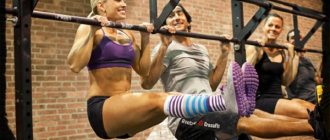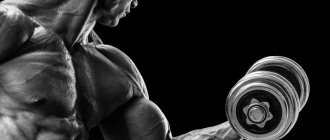This 6-day-a-week training program is intended for experienced athletes with good recovery abilities of the body. In addition, such a frequency of training in the gym requires you to strictly adhere to the correct daily routine. Particular attention must be paid to adequate and balanced nutrition. Otherwise, the six-day training program will not work for you.
A 6-day-a-week workout program can be used for both muscle gain and weight loss. Achieving one or another goal depends mainly on your diet. The duration of the training program for six days a week is 12 weeks. Then you should take a break for a week and repeat the cycle or change the program.
Now I will give examples of how to create a training program for 6 days a week to gain muscle mass or burn excess subcutaneous fat, for experienced and advanced athletes. There will also be an option for a six-day gym training program for girls.
Training process
Training programs - or rather their construction - is a difficult stage for any trainer.
The processes of constructing a training cycle should be divided into:
- Building workouts to gain muscle mass
- Building workouts for weight loss
In any case, the crucial point will be the nutrition factor (calorie surplus or deficit).
Surplus – we spend less energy than we consume.
Deficit – energy consumption is higher than consumption.
The primary role is played by the nutrition process; training may not change at all.
How hard should you train to gain muscle mass?
One of the first questions that haunted me when I started studying. Namely, what number of repetitions is best and why? Is the 10-12 rep range beloved by everyone in fitness magazines really the most effective? Or maybe more? Or less? To be honest, I very quickly became convinced that the answer to this question is quite difficult. The sheer number and variety of expert opinions leaves you scratching your head, wondering which one to believe.
However, this was several years ago, but since then I have studied this question in quite some depth, talked to hundreds of people, and I think I have an answer worth sharing. And what’s good is that you can quickly check the accuracy of my advice. Use it and within 4-6 weeks you will know whether it works or not. And for greater clarity, let's briefly recall the physiology of muscle growth.
Optimal number of workouts per week
The “golden” average for the number of workouts per week will be 3 workouts: for a beginner. Depending on the goals, the training process should be divided into 2 types:
Split – distribution of muscle group training on different days of the cycle/week.
Fullbody is a system that involves working out all muscle groups in one workout.
Flaws
Despite such powerful advantages, split programs also have disadvantages:
- High level of difficulty
There are schemes that will suit almost everyone. However, the training volume per muscle group increases several times and for some this becomes too difficult a task.
- Frequent workouts
This mainly applies to 4-6 day programs. Not everyone has the opportunity or need to visit the gym so often.
Most amateurs stick to three-day splits. This is the best option for muscle growth, recovery of the body, and in terms of time costs.
SPLIT style workouts
So, we have 3 workouts per week in our arsenal, how to correctly create a plan (one of the options):
1. Chest and triceps 2. Shoulders and legs 3. Back and biceps
Or this option:
1. Shoulders and legs 2. Chest and biceps 3. Back and triceps
If we train 4 times a week, training schemes can be built as follows:
- Legs
- Chest and triceps
- Back and biceps
- Shoulders (working all 3 beams).
5 day training split:
- Legs
- Breast
- Back
- Shoulders (working all 3 beams)
- Biceps and triceps.
In the case of a 6-day split, you can perform each muscle group on a separate training day.
Want my customized cycle training program? Write through contacts and I will send it to you for free (with the note: I want free training).
SIX-DAY SPLIT FOR WEIGHT
This option is most often used by professional athletes. Every day a separate muscle group is worked out. Thus, during a weekly microcycle, the athlete works out the entire body.
MONDAY (QUADRICEPS, BICEPS THIGH, CALVES)
- Squat 3-4x10-12
- Deadlift 3-4x8-10
- Leg press 3-4x12
- Lunges 3x8-10
- Standing calf raise 3x12-20
- Seated calf raise 3x12-15
TUESDAY (CHEST MUSCLES)
- Bench press 3-4x6-8
- Incline press 3-4x8-12
- Reduction of hands 3x12
- Pullover 3x10-12
WEDNESDAY (BACK MUSCLES)
- Pull-ups 3-4x6-12
- Bent-over row 3-4x8-10
- Traction in Hummer 3-4x8-12
- Shrugs 3x10-12
THURSDAY (DELTOID MUSCLES)
- Standing press 3-4x6-8
- Chin row 3-4x6-8
- Dumbbell press. sitting 3x8-12
- Deadlift Lee Haney 3x8-12
- Side swings 3x12
FRIDAY (BICEPS, FOREARMS)
- Barbell curl for biceps 3x6-8
- Arm curls with dumbbells 3x8-12
- Hammers 3x8-12
- Wrist curls with barbell 3x8-10
SATURDAY (TRICEPS)
- Close grip press 3x6-8
- French bench press 3x8-10
- Arm extension on a block 3x8-12
SUNDAY (rest)
Muscle Growth Factors
Progression in loads (mechanical stress);
Metabolic stress;
Microtrauma of muscle fibers.
There is a fourth separate, important factor - the increase in the concentration of anabolic hormones in the blood, the most important of which are testosterone and growth hormone. This fact is precisely related to the popular practice of using steroids in sports.
Your next task will be to be able to combine the above factors.
Super compensation
The human body is an adaptive system that physical activity forces to change and adapt to new conditions.
Therefore, post-workout recovery and an increase in strength and energy in the muscular system are not limited to just replenishing lost reserves. As Soviet scientist Nikolai Yakovlev proved in 1959 , the body instead enters a period of supercompensation, during which the tired muscle becomes a little stronger, a little larger in size compared to its pre-training level. If you train during this period, then each subsequent recovery will result in a new supercompensation, which means a new increase in size and an increase in strength. This theory is true for most speed-strength sports and is called the basic principle of athletic training.
Muscle growth is not the result of the exercise itself, it is the result of rest after exercise. That is, our task is to capture this moment of grace. Too frequent loads (before overcompensation occurs) lead to overtraining (overfatigue), and too infrequent loads lead to a lack of progress. All training programs are based on this - load as much as possible, “shock” certain muscle groups, then give them enough rest, reach a new strength and energy level (supercompensation period), in order to again “shock” and “injure” them constantly - with progressive load. There are many ways to correctly create a training program, but they all are based on one indisputable principle:
The more intense each individual workout, the less often you need to train. For example, let's take the most effective (time-tested) program for beginners - the FULL BODY program.
It allows beginners to quickly become stronger in basic exercises, but it is not recommended for use in the future. If you squat, bench, pull-up, and do push-ups on the same day, progression of the load soon becomes impossible. It’s simply not possible to maximally load the muscles in all exercises, which is why they switch to division (split training).
Whole body for a workout. Abridged version by Stuart McRobert
The golden thread runs through all the chapters of the book “Think. Bodybuilding without Steroids” was based on the idea that “natural” training should have a limited volume, significantly different from that in traditional programs. Both the amount of work per muscle group and for the entire workout as a whole. Below is an option that may be suitable for those who do not have the opportunity to go to the gym three times a week and have a very limited amount of time for the workout itself. That is, it is much better than nothing.
Whole body workout, option #1:
- Squats or deadlifts (alternately, through training);
- Bench press;
- Pulldown on the block with a parallel grip;
- Standing calf raise in the machine.
Number of working approaches: 1–3. Number of repetitions: 8–15 (for squats, 20 are allowed). Rest after training: 3–5 days. The exercises are performed alternately,
Modified version of the Doggcrapp system
The original Doggcrapp system is very similar to a two-day split, as it involves working half of the muscle groups per workout. The frequency of training one muscle group is once every three to four days, but the set of exercises for the main muscles changes at each workout. In Doggcrapp's system this is fundamental. Another difference between the Doggkrapp system is that it involves only one working approach per muscle group using various methods of “intensification” (rest-pause, etc.). Since science and practice have proven that one approach is clearly not enough for maximum stimulation of muscle growth, and also that with frequent loads on the same muscle group, it is more rational to vary the load regimes within the microcycle, a modified version of the Doggkrapp system is proposed.
This option provides a two-week microcycle consisting of 6 workouts, three workouts for each muscle group. At each workout, the load mode changes for a separate muscle. The program is designed for gaining muscle mass by athletes who do not use pharmacological means of recovery, from beginner to advanced levels, that is, those who are still far from shifting their emphasis to lagging muscles. The use of intensification methods, such as rest-pauses or static holds recommended by Dante Trudel, is not provided, that is, it is enough to complete each approach to failure.
“Strength, Muscle and Fire”: notes and comments
- Refusal.
I do not advise you to work to the point of complete failure. Try to perform each set until you feel like you can’t do another repetition, and at that point stop the exercise. If at some point you accidentally reach this point of failure, it’s okay, but you don’t need to purposefully paint yourself into a corner with every approach. - Movement towards the goal.
Your main goal is to progress during each workout and each approach. Sets performed carelessly are a waste of time and effort. If you are not feeling well or have little time, do not chase the number, but focus on fewer quality approaches. - Split options.
Of course, you have the right to adjust the training program to your schedule, but do not forget that it is not advisable for a natural bodybuilder to exercise more than 4 times a week. Which split is the best? One that you can stick with for a long period of time. - Minor changes.
What if I don't want to stick to the 6-12 rep rule and want to do 6 to 10 reps? Feel free to move on to 6-10 repetitions. What if I don't like the idea of 3-5 reps on a strength set? Then do 4 to 6 repetitions. Having a hard time doing 40 reps on a fire set? Go for 30 muscle-burning reps. Comment: Minor changes are fine as long as you adhere to the fundamental principles of this training program. Don't focus on the little things - just think about how to lift more weight and get bigger! - Alternating exercises.
It's not a bad idea to alternate exercises every week. It is clear that it is impossible to perform all the exercises for the target group in one training session. For example, as a muscle set for the pectoral muscles, you can use dumbbell flyes one week, and dips the next. - Total number of approaches.
It is better to start with a minimum number of approaches, and when you feel that it is time to increase the load, add the number of approaches to your training program. - Calf muscles.
Please note that there are no strength sets for the calf muscles. I have no reason to believe that the calf muscles respond well to low reps. - Quadriceps.
If you like to endure pain, add an isolated set of 20 squats to your fire quadriceps sets.











